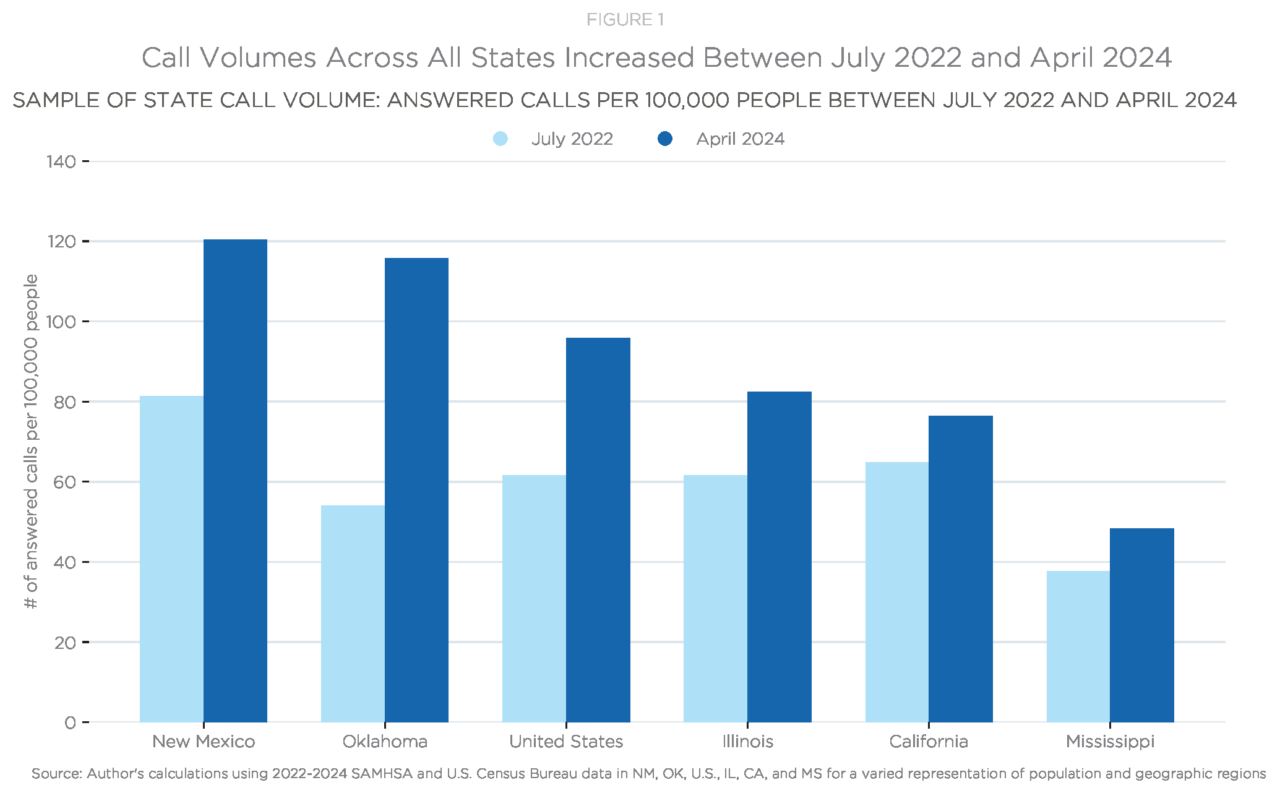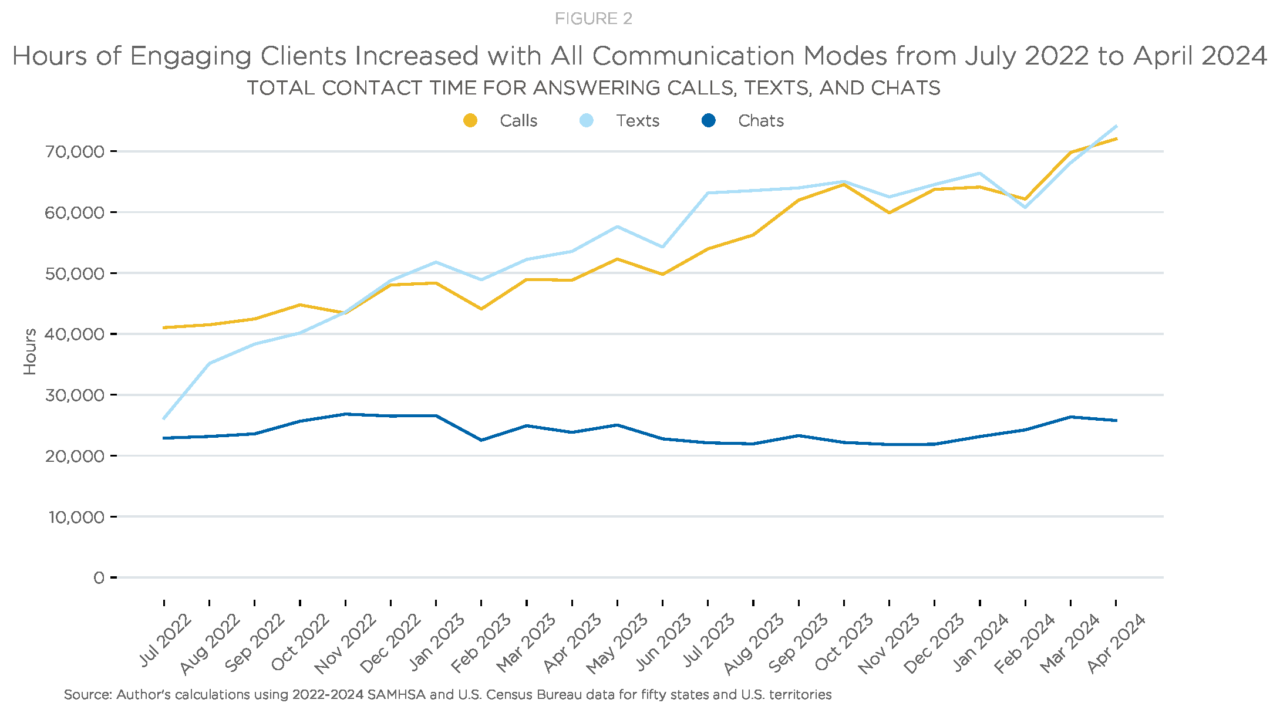By Daniel Kim, Intern
In July 2022, the US launched 988, a simplified number to access the national Suicide and Crisis Lifeline. The program offers 24/7 free and confidential counseling services and mental health resources nationwide by dialing 988 through phone, text, or chat. It is operated by a network of about 200 local, independent crisis centers. When the national suicide lifeline was established in 2005, the 1-800-273-8255 lifeline received 46,000 calls in the first year between 2005 and 2006 for mental health support (FCC). After the change in phone number, the 988 lifeline received almost 5 million contacts asking for support in the first year between July 2022 and July 2023 (SAMHSA).
Local leaders have an important role to play in supporting local mental health resources like those offered through 988. Data from the 988 lifeline’s first two years of operation reveals avenues for city leaders to better understand local mental health needs and to increase the visibility of existing resources. NLC analyzed data from SAMHSA‘s monthly reports and the U.S. Census Bureau to understand how the service has been used and to identify opportunities for action from local officials. Since the most recent data for state population estimates is from 2023, NLC used the 2023 state population estimates for April 2024. The states selected were California, Illinois, Mississippi, New Mexico, and Oklahoma for a varied representation of population and geographic regions.

Between July 2022 and April 2024, all selected states’ local crisis centers generally experienced an increase in the number of calls answered per 100,000 people. In April 2024, New Mexico and Oklahoma surpassed the U.S.’s calls answered per 100,000 people. New Mexico achieved approximately 120 calls answered, marking an increase of around 47% from its performance in July 2022. Oklahoma reached around 116 calls answered, highlighting a percentage increase of approximately 114% over the same period. On the other hand, Illinois (roughly 82 calls answered), California (76 calls answered), and Mississippi (48 calls answered) fell behind the national average, suggesting potential challenges or slower growth rates in using or accessing the 988 lifeline. New Mexico recently expanded its mobile crisis intervention teams and Oklahoma started a creative public awareness campaign, which could have contributed to the jump in the number of calls.
In July 2022, the collective time counselors dedicated to engaging clients via calls amounted to approximately 41,031 hours (or roughly 4.5 years), with texts totaling roughly 26,161 hours (or almost 3 years) and chats accounting for 22,884 hours (or about 2.5 years). By April 2024, the time spent on client service through calls surged to approximately 72,009 hours (or almost 8 years), while texts accumulated 74,061 hours (or about 8.5 years), and chats rose to 25,770 hours (or about 3 years). This represents a percentage increase from July 2022 to April 2024 of approximately 75% for calls, roughly 184% for texts, and about 13% for chats.

While looking at national-level data clarifies the overall picture of 988 usages, it is critical for states and local governments to analyze their data for insights into local mental health trends and interventions. Here are some examples of how different states are monitoring and improving 988:
- Crisis centers from Arizona, South Dakota, and Utah have dashboards that show aggregated data, including reasons for calling and referral sources.
- Illinois created a task force to monitor the progress of the 988 programs in its state to address specific issues.
- Maryland recently passed a bill that provides permanent funding for 988.
Overall Picture and Recommendations
The 988 lifeline has improved and increased in usage over the past 2 years. Calls and texts are the most common methods of contact for clients to access 988, accounting for roughly 84% of total volume. Despite the growth in use of the lifeline, a 2023 survey from Pew Charitable Trusts reveals that only 13% of the public knows about 988’s existence and its purpose.
This points to opportunities for:
- Local governments to ensure adequate funding and training for local crisis centers’ ability to address both calls and texts.
- Local governments to promote public awareness of the 988 lifeline, including specific campaigns towards the specialized resources available for non-English speaking and LGBTQIA+ communities.
- Promoting 988 performance data consistency and transparency on a local level to help plan targeted interventions – specifically, ensuring that aggregate data is shared with local health departments, school districts, and other relevant parties.
- Making the 988 datasets easily available to download for research purposes.
- Working with state officials to sustain and/or expand funding for 988.
- Exploring root causes in states with low call rates and states with large call increases and underlying reasons behind the large number of hours with call and text time to improve service.
How a simple board game changed a City Council for the better
Being an elected leader isn’t always fun and games, but sometimes it can be. Learn how the Parker, CO City Council used a board game to inspire more group cohesion and approach the difficult conversations surrounding challenges like housing, infrastructure and equity. Read on to learn how it worked for them and how you can take the same approach in your community.










